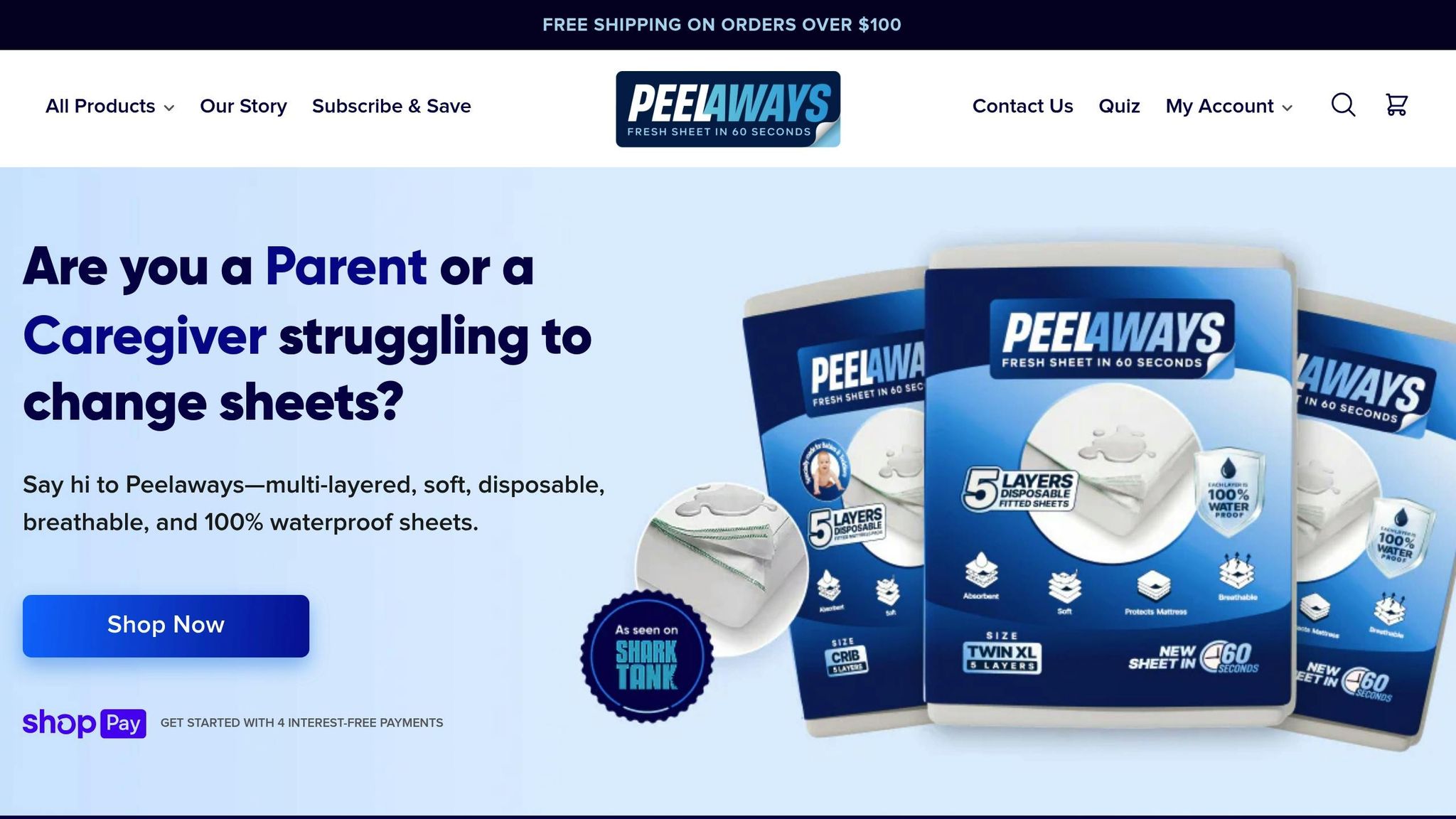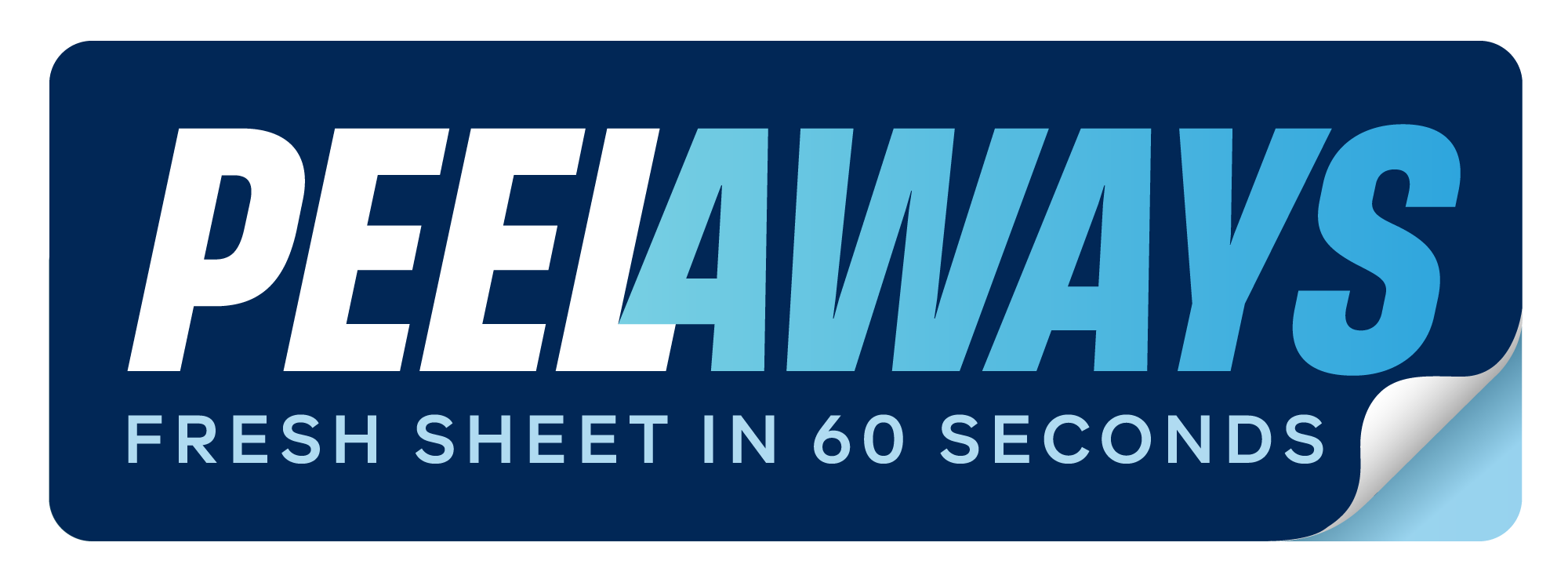Checklist for Reducing Laundry in Hospitals

Managing hospital laundry is a complex, expensive process that impacts budgets, staff workload, and infection control. Hospitals spend millions annually on linen management, making it essential to find ways to reduce costs and improve efficiency. Key strategies include:
- Adopting disposable bedding solutions like PeelAways, which minimize laundering needs, reduce contamination risks, and save time.
- Improving linen collection and sorting with color-coded bags, RFID tracking, and clear policies to streamline processes and cut waste.
- Enhancing infection control by using PPE, separating clean and soiled linens, and maintaining laundry facilities to prevent healthcare-associated infections (HAIs).
- Training staff regularly on handling linens, reducing waste, and using disposable options to improve workflows.
Hospitals that implement these measures can cut laundry-related costs by up to 20-25%, save labor hours, and improve patient care while maintaining strict hygiene standards.
Washing Dirty Laundry? The Risks in Handling Hospital Linen
Improving Laundry Collection and Sorting
Streamlining how soiled linens are collected and sorted not only lightens the workload for staff but also helps maintain strict health and safety standards.
Set Up Efficient Sorting Systems
Color-coded, leak-resistant bags are a simple yet effective way to sort linens quickly and accurately while preventing fluid leaks. For instance, red bags can be reserved for biohazardous materials from isolation units, while blue or green bags can handle general patient linens. This system minimizes errors and ensures a safer process for everyone involved[7].
Strategically placed, clearly labeled sorting stations throughout the facility can make a big difference. By reducing the distance staff need to carry soiled linens, these stations cut down on unnecessary handling and transport time[7]. Clear signage at each station helps staff easily identify where different types of linens should go, even during hectic shifts.
One hospital in a major city took this a step further in 2022 by introducing RFID-based linen tracking. This tech-driven approach reduced linen purchase costs by 20% and saved $100,000 annually by optimizing inventory and cutting waste[5]. These types of sorting systems create a foundation for consistent and efficient linen handling practices.
Create Clear Policies for Handling Soiled Linens
Well-defined policies make all the difference when dealing with soiled linens. For example, a strict rule limiting bags to two-thirds full can prevent overloading, which often leads to tears and spills[6].
Properly sealing bags is just as important. Staff should use secure knots or closures to contain odors and prevent spillage. Bags should always be sealed immediately once they reach the fill limit[6].
Safe handling practices are non-negotiable. Gloves should always be worn, and bags should never be carried against the body. Additionally, carts and sorting stations must be routinely disinfected to reduce the risk of cross-contamination[7].
To ensure everyone is on the same page, visual aids and regular training sessions can reinforce these policies. A dedicated linen policy committee can also help fine-tune procedures and address any challenges as they arise[9].
Tracking key metrics like the time it takes to turn soiled linens into clean ones, linen loss rates, cross-contamination incidents, and staff hours spent on laundry can highlight areas for improvement. Regular audits ensure that these policies are consistently followed and help identify any bottlenecks that need attention[4].
Infection Control in Linen Management
Managing linens with proper infection control measures is crucial for protecting both patients and healthcare staff while reducing the risk of healthcare-associated infections. A key starting point is ensuring staff use the right protective gear when handling soiled linens.
Use PPE for Laundry Handling
The use of personal protective equipment (PPE) - such as gloves, masks, gowns, and eye protection - is non-negotiable when dealing with soiled hospital linens. This gear acts as a barrier against exposure to bloodborne pathogens and other infectious agents[6]. The CDC emphasizes that PPE serves as the first line of defense against contamination. Regular training sessions on how to properly put on and take off PPE, along with visual reminders, can help staff stay vigilant and consistent in their practices[7].
Once PPE is in place, strict protocols to separate clean and dirty linens become the next priority.
Keep Clean and Dirty Linens Separate
Clean linens should always be stored in designated, covered areas, completely separate from soiled materials. According to CDC guidelines, soiled linens should be placed directly into designated containers without being carried against the body to minimize the risk of spreading infections during transport[6]. Using separate carts and routes for clean and dirty linens further reduces the chance of cross-contamination. Additionally, routine cleaning and disinfection of storage spaces help maintain a hygienic environment.
Beyond PPE and segregation, the cleanliness and upkeep of laundry facilities play a vital role in infection control.
Maintain Laundry Facilities Regularly
Laundry equipment should be regularly inspected and maintained to meet hygiene and temperature standards[2]. The CDC recommends that laundry facilities use materials for floors and walls that are easy to clean and disinfect[6]. Ventilation systems also require attention, with regular filter changes and duct cleaning to prevent contamination. Deep cleaning behind machines and in hard-to-reach corners ensures that every part of the facility contributes to a safe and sanitary laundering process.
sbb-itb-45288fe
Using Disposable Bedding Solutions
Disposable bedding provides an efficient and hygienic alternative to traditional linens, simplifying infection control and enhancing patient comfort. By eliminating the need for labor-intensive laundry processes, these solutions streamline operations while maintaining high standards of cleanliness.
Benefits of PeelAways Sheets

PeelAways sheets feature a patented multi-layer design with 5 to 7 soft, absorbent layers, depending on the size. When a layer becomes soiled, staff can simply peel it away to reveal a fresh, clean sheet underneath. This waterproof design minimizes the risk of cross-contamination, a common challenge with traditional linen management.
These sheets are available in various sizes to fit all major U.S. bed dimensions:
- Cot sheets (7 layers): $34.99
- Twin XL (7 layers): $41.99 (ideal for longer hospital beds)
- Twin to King sizes: $34.99 to $53.99
- Crib-A-Peel (5 layers): $30.99, designed for pediatric units
By bypassing the need for laundering, PeelAways sheets offer a fresh, uncontaminated surface for each use. This is especially beneficial for patients with mobility issues or incontinence, as it supports both hygiene protocols and patient dignity. Additionally, these FDA-registered sheets are hypoallergenic and free from chemicals, ensuring patient comfort alongside strict cleanliness standards. Healthcare facilities can also take advantage of volume discounts and institutional pricing, with gift card options available for flexible purchasing.
Reducing Labor and Cross-Contamination
Beyond improving hygiene, disposable sheets significantly reduce labor demands. Traditional linen handling - collecting, sorting, washing, drying, and redistributing - requires time, effort, and coordination across multiple departments. With PeelAways, staff can change bedding in seconds without the need for mattress lifting, cutting down on physical strain and lowering the risk of workplace injuries.
Cross-contamination risks are also drastically reduced. Soiled layers are immediately removed and disposed of following hospital waste protocols, eliminating the need to transport and handle contaminated linens. Each new layer provides a sterile surface, which is particularly vital in high-risk scenarios such as isolation rooms, emergencies, or outbreaks.
Hospitals that have optimized linen management have reported 20-25% reductions in laundry costs through better tracking and usage strategies. Disposable bedding can amplify these savings by eliminating laundry cycles for bedding entirely, reducing labor, utility, and supply expenses. It also frees up storage space previously required for large linen inventories.
While disposable sheets may have a higher upfront cost compared to laundering traditional linens, the overall savings are substantial. Reduced labor, utility costs, and infection risks, along with fewer staff injuries, make these solutions especially cost-effective in high-turnover units where bedding changes occur frequently. Incorporating disposable bedding into hospital workflows supports safer, more efficient, and cost-conscious patient care.
Training Staff and Improving Workflows
Effective staff training is the backbone of successful laundry reduction strategies in hospitals. Teaching employees how to properly use disposable bedding solutions not only cuts costs but also supports high standards of patient care by improving inventory management and minimizing waste[5].
Run Regular Training Sessions
Regular training sessions should focus on key areas to ensure staff can effectively implement laundry reduction practices. A primary focus is infection control protocols, which include proper use of personal protective equipment (PPE) when handling soiled linens and maintaining strict separation between clean and dirty materials. For example, the CDC recommends wearing gloves and using clearly labeled containers for soiled linens to prevent contamination[6].
Practical training on installing PeelAways sheets is equally important. Staff should learn how to position the tags correctly, recognize when a layer needs changing (typically every 7-10 days or immediately when soiled), and master the peel-away technique that reveals a clean sheet underneath[1].
"They said it is more convenient to use than sheets, less washing, just peel off soiled layer and throw out." - Kalahiki Jr Samuel[1]
Emergency response protocols should also be included to prepare staff for handling patient surges efficiently[4].
To reinforce these practices, use clear signage and posters near linen carts and soiled linen containers. These visual reminders help staff stay consistent with protocols throughout their shifts[9]. Additionally, regular audits can pinpoint areas where training needs improvement. Forming a linen policy committee with representatives from various departments ensures accountability and addresses practical challenges[9].
Strong training programs lay the groundwork for smoother staff rotations, which further streamline workflows.
Improve Staff Rotations and Tasks
Once staff are well-trained, optimizing rotations can reduce workloads and lower the risk of injuries. Cross-training employees on tasks like sorting linens, transporting them, and applying disposable bedding creates more flexibility in scheduling and helps balance workloads across the team[2][5].
Rotating tasks - such as alternating between bed-making, inventory management, and disposable bedding use - helps minimize repetitive strain while improving efficiency.
Disposable bedding solutions, like PeelAways sheets, also significantly ease physical demands on staff. These sheets allow workers to change bedding in under a minute without stripping the bed, eliminating heavy lifting and awkward movements. This streamlined process enables staff to clean more rooms in less time while reducing physical strain[1].
Technology can further enhance workflows by providing real-time data on linen usage. RFID tracking systems and automated inventory management tools give staff insights into linen distribution and peak usage times[5][7]. Supervisors can then adjust staffing levels and rotations based on actual demand rather than estimates.
To maintain balance, monitor workload distribution to ensure no one employee is overburdened while others have lighter tasks. Regular feedback sessions with staff can uncover workflow challenges and highlight opportunities for improvement. Including employees in policy development fosters a sense of ownership and encourages compliance with new procedures[4][8].
Engaging staff is essential, as many employees may not fully understand the financial impact of linen loss and waste. Explaining how these efforts contribute to cost savings can motivate workers to consistently follow established protocols[9].
Key Points for Reducing Hospital Laundry
Reducing the workload of hospital laundry requires a well-rounded approach that blends efficient processes, staff education, and smart technology. Hospitals that have implemented effective linen management systems have reported impressive outcomes. For example, some facilities have cut linen purchase costs by 20% and saved as much as $100,000 annually[5].
A key step in this process is upgrading to high-efficiency laundry equipment. These machines, equipped with sensors, adjust water, detergent, and cycle times based on the size and soil level of each load. In a typical hospital, this can save tens of thousands of gallons of water each month and significantly lower energy expenses[3]. However, technology alone isn’t enough - well-trained staff play a crucial role in maximizing these benefits.
Through effective staff training and regular audits, hospitals can reduce linen loss by up to 20%[9]. When employees are taught proper linen handling techniques, they contribute directly to cutting costs and improving efficiency.
Integrating technology into laundry operations also brings transformative results. RFID tracking systems and inventory management software help monitor usage patterns in real time, ensuring optimal ordering and preventing both shortages and overstocking[5][7]. Additionally, disposable bedding solutions like PeelAways sheets offer a practical alternative. These sheets allow staff to peel away soiled layers in less than a minute, reducing labor demands and minimizing cross-contamination risks.
"No more 15 loads of laundry and wet mattresses!" - Jalene Stanger[1]
Using disposable bedding eliminates the need to transport soiled linens, which not only cuts down on laundry loads but also reduces the risk of spreading infections[6]. This solution is particularly useful in high-turnover areas, such as elder care and medical recovery units.
Another advantage of disposable bedding is its impact on water and energy conservation. However, facilities must ensure sustainable disposal practices to address environmental concerns[3][4].
FAQs
How can disposable bedding like Peelaways help hospitals maintain better infection control?
Disposable bedding options like Peelaways offer a practical way to improve infection control in healthcare environments. With their patented multi-layer design, you can simply peel off a used layer to reveal a clean, fresh sheet underneath. This eliminates the need for traditional laundering, cutting down on the risk of cross-contamination while also saving valuable time.
By reducing the need for excessive handling and avoiding the hassle of lifting mattresses, Peelaways contribute to maintaining a cleaner, safer environment - essential for protecting patients and preventing infections in hospital settings.
How can hospitals improve linen management and reduce laundry workloads?
Hospitals can simplify linen management and cut down on laundry tasks by adopting modern solutions like disposable bedding. Take Peelaways, for example - these multi-layer, disposable bed sheets provide a convenient alternative to traditional linens. Instead of frequent washing, you simply peel off the soiled layer to reveal a fresh sheet underneath. No need to lift mattresses or deal with heavy laundry loads.
This method not only lightens the workload for staff but also reduces the risk of cross-contamination, creating a cleaner and safer environment for both patients and caregivers. Disposable bedding is particularly useful in busy healthcare settings where maintaining hygiene and efficiency is essential.
What are some ways hospitals can manage costs when using disposable bedding instead of traditional laundry?
Hospitals can cut down on costs efficiently by integrating disposable bedding options, such as Peelaways, into their routine. These sheets are designed with multiple waterproof layers, allowing staff to simply peel off a soiled layer to reveal a fresh one. This eliminates the constant need for laundering, saving time, water, and energy.
By adopting disposable bedding, healthcare facilities can reduce labor demands and lower the risk of cross-contamination. This streamlined approach lets hospitals prioritize patient care while ensuring a clean and organized environment.
Related Blog Posts
- 5 Steps for Handling Contaminated Linens Safely
- How Disposable Sheets Reduce Cross-Contamination
- Reducing Pathogen Spread: Cleaning Protocols Explained
- How to Prevent Cross-Contamination in Bedding
Comments
0

SAVE MONEY & WATER
Professionals & Institutions save a fortune on labor/laundry.

SUPERIOR COMFORT
The first thing our customers notice is how soft our sheets are.

100% WATERPROOF
Each layer is 100% Waterproof, perfect for spills and accidents

SAVE TIME
Change the sheet in under 1 minute without stripping the bed.




Leave a comment